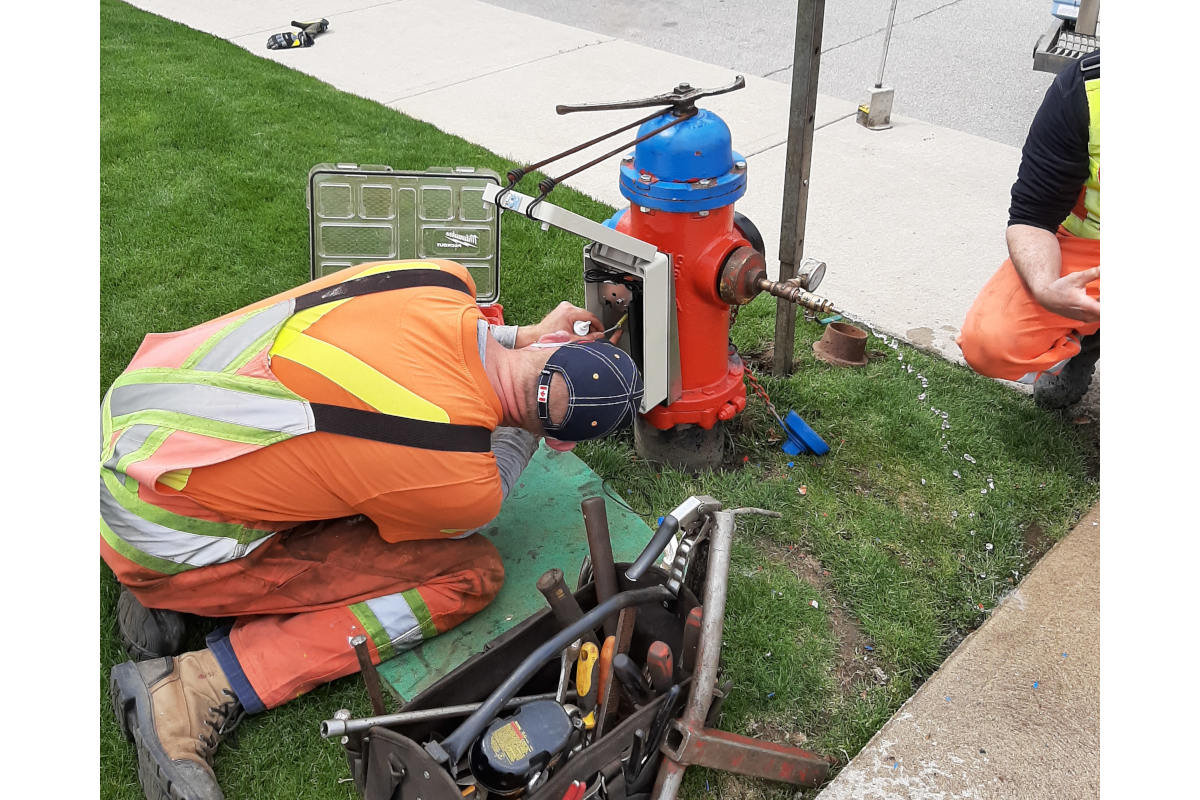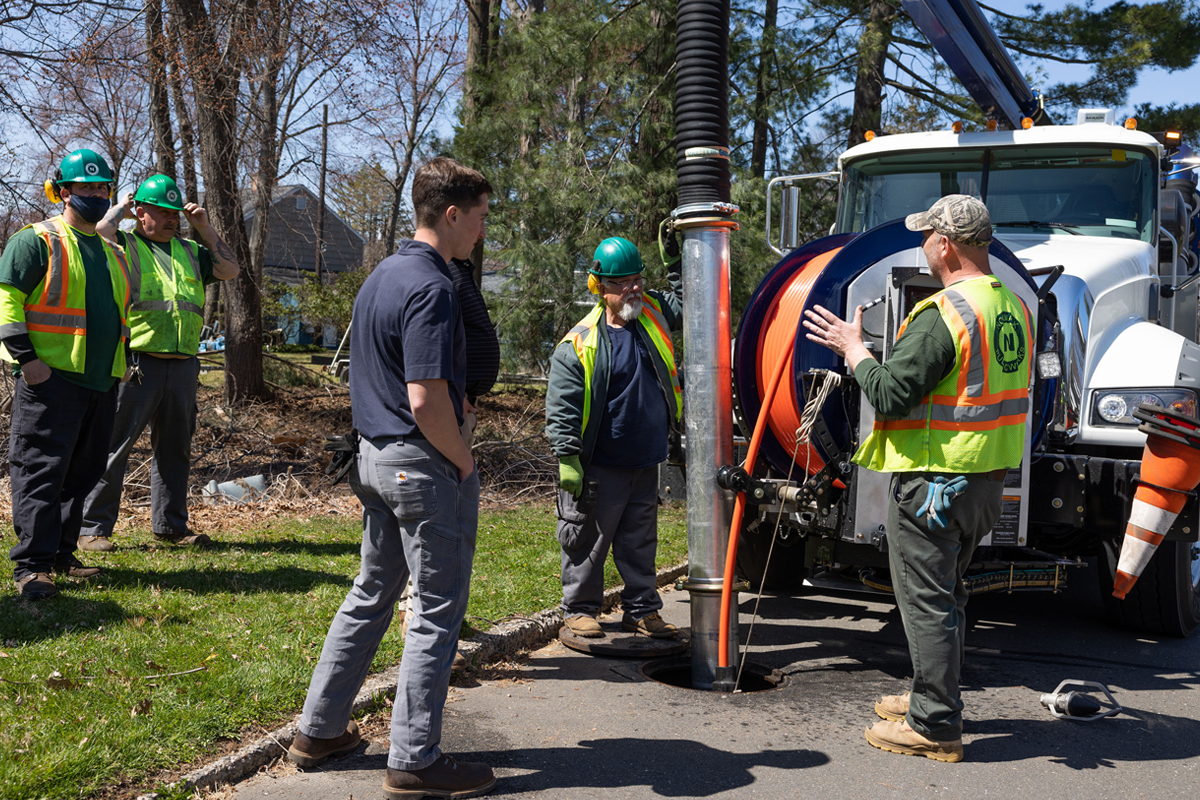
Envirologics Engineering Expanding Tomahawk System
January 11, 2016

By adding a pre-calculated amount of polymeric coating to the airstream followed by the deployment of a proprietary distributive body to pull through the pipe, Envirologics engineers found they could create controlled turbulence, which evenly spreads the coating around the full, inner diameter of the pipe.
After finding success cleaning water pipes using abrasive stones and low-pressure air, Envirologics Engineering Inc. is in the process of expanding the capability of its Tomahawk System.
The Tomahawk System — commercially available since 2012 — removes tuberculation, corrosion, biofilms and old tar-based liners in potable water pipes. The system can clean pipes from 4- to 12-in. diameter and up to 500 ft in length. When the cleaning is complete, the utility owner is left with a clean, dried and inspected pipe suitable for rehabilitation with sprayed-in-place pipe (SIPP) or cured-in-place pipe (CIPP) lining.
“Tomahawk was initially developed to be an airborne abrasive cleaning system. It provides a high-quality abrasive blast finish and dries the pipe in preparation for a CIPP or SIPP product lining,” says Brian Thorogood, P.Eng, general manager.
RELATED: Pipe Cleaning System Removes Tuberculation, Corrosion, Biofilms and Tar-based Liners
As is often the case through a product’s development cycle, things change. In Envirologics’ case, about two years into the development of the Tomahawk System, engineers noted that, in many instances, the cleaned pipe was structurally sound and could be rehabilitated using a thin, well-bonded barrier coat as opposed to a semi-structural SIPP liner or a fully structural CIPP liner.
This prompted Envirologics engineers to develop an application system for this thin barrier coat that used the airborne application methodology and much of the same equipment already onsite during the Tomahawk System cleaning.
A Barrier is Born
By adding a pre-calculated amount of polymeric coating to the airstream followed by the deployment of a proprietary distributive body to pull through the pipe, engineers found they could create controlled turbulence, which evenly spreads the coating around the full, inner diameter of the pipe. What is created is a pipe that is fully lined with an American Water Works Association (AWWA) M28, Class 1, barrier coating.
“What we found is that we could line the pipe very fast. Lining 100.58 m (330 ft) in less than 20 minutes,” Thorogood says. He added that the Class 1 barrier coat is also less costly than other lining products currently available and can extend pipe life for decades.
The AWWA divides pipe liners into four classes. Class 1 is a non-structural liner used for coating and corrosion protection, Class 2 and Class 3 are interactive, semi-structural liners, and Class 4 is a fully- structural liner. In some instances, Class 2, 3 and 4 liners are not required and the utility owner can save a considerable amount of money and time by rehabilitating the pipe with a Class 1 barrier coat instead. According to Thorogood, Class 1 may be all that is required if the problem is limited to internal corrosion and build-up of biofilm.
“A Class 1 barrier coat can add years of additional life for your pipes says Jacqui Kramer, project engineer at Evanco Environmental. Evanco Environmental is a sister company to Envirologics and provides water and sewer rehabilitation repairing and rehabilitating services, including the Tomahawk System. “You are not throwing your money at replacing a pipe that does not need to be replaced for another 20 or 30 years.”
RELATED: Power in the Province
Unlike the cleaning and prep end of the Tomahawk System, which can be followed by any AWWA Class 1 through Class 4 liner, the Tomahawk barrier coat system is designed specifically to work with only the Tomahawk System cleaning. Thorogood likens it to painting a car. The metal needs to be clean, clear of debris and dry for the coating to adhere properly. The Tomahawk System is the only pipe cleaning system that covers all of those bases for all pressure water lining systems.
The airborne barrier coating is ideal, Thorogood says, when addressing pipes because of red water or pressure complaints. A caveat to using the barrier coat is that the pipe being sprayed cannot have a break or leakage history.
“We do not profess this to be a system that is a one-tool to fit all, but we do see a huge market that is underserved out there right now,” he says. “If there is a break history, this is not the right technology. If there is a break history, the engineer needs to better define whether a semi or fully structural liner is required.”
- This trio of photos show a pipe before it is cleaned with, after a cleaning with the Tomahawk System and after the application of the Tomahawk barrier coating.
- This trio of photos show a pipe before it is cleaned with, after a cleaning with the Tomahawk System and after the application of the Tomahawk barrier coating.
- This trio of photos show a pipe before it is cleaned with, after a cleaning with the Tomahawk System and after the application of the Tomahawk barrier coating.
Real World Testing
A demonstration of the airborne barrier coating system took place in July 2015 in Waterloo, Ontario, on a section of pipe slated for abandonment. Jonathan Pearce, inspector and project manager for the City of Waterloo, helped coordinate the demo. Pearce is past chairman of the Centre for Advancement of Trenchless Technologies (CATT) and no stranger to the Tomahawk System.
This is the second year Waterloo has provided cast-iron pipe to Envirologics for field testing purposes, and the City had help prepping the site from Ersman Construction, the contractor charged with installing the new sewer and water infrastructure. According to Pearce, like the City, Ersman Construction is receptive to seeing new technologies in action.
“Ersman Construction sees the potential in this and likes being part of a forward-looking organization. I like to think that this whole Tomahawk system has a huge potential down the road when you look at the deteriorating infrastructure,” Pearce says. “There is a need for a potential same-day return-to-service scenario that this technology can do. You could conceivably make a section of water main available, clean it, line it and put it back in service within that same day.”
This is important when considering tight municipal budgets and the cost of water bypass systems for relining projects. Similarly, the barrier coating system offers a lower cost alternative to those experiencing what Pearce referred to as aesthetic issues of water — discoloration, decreased pressure, declining chlorine residuals — on a line with no history of breaks.
“When you work in municipalities, budgets are a critical item, so if you have “x” amount of dollars and you go down the structural liner road, you can only do so many kilometers of rehab,” Pearce says. “With a barrier coat, because of the lower cost, you can do more with the same amount of money.”
In addition to allowing the demonstration to take place on its abandoned line, the City also took sections of the line —before cleaning, after cleaning and after barrier coating — and sent it to the University of Waterloo, CATT’s base of operation, for analysis.
RELATED: Researchers Work with Cities to Develop Strategic Water Management and Financing Tool
“We [Waterloo] have tried to maintain a perspective of doing what we can to help advance the trenchless industry and innovative solutions. I think that the Tomahawk cleaning and lining systems is innovative,” Pearce says. “I look at it as a learning opportunity for everyone here at the City, and I think the learning opportunity should not be passed up. Every new technology or idea has to have an opportunity to be tried in the field so that the weaknesses or the errors can be addressed so that the industry can move forward, and that technology can move forward.”
Market Availability
In terms of market availability, Kramer and Thorogood say the Tomahawk System barrier coating method is targeted to be commercially available in 2016, and throughout the year will continue product demonstrations and small projects. The next demo is set for the spring in Kingston, Ontario.
At this time, the bulk of the research on the barrier coating system is focused on 6-in. pipe, which is the predominate water distribution system pipe size in North America, but once complete, the system will be available for pipes from 4- to 12-in. like the cleaning system.
Kramer adds that they are also looking at using the cleaning and coating system to provide life extensions and encasement for asbestos cement pipes.
Mike Kezdi is associate editor of Trenchless Technology Canada.







